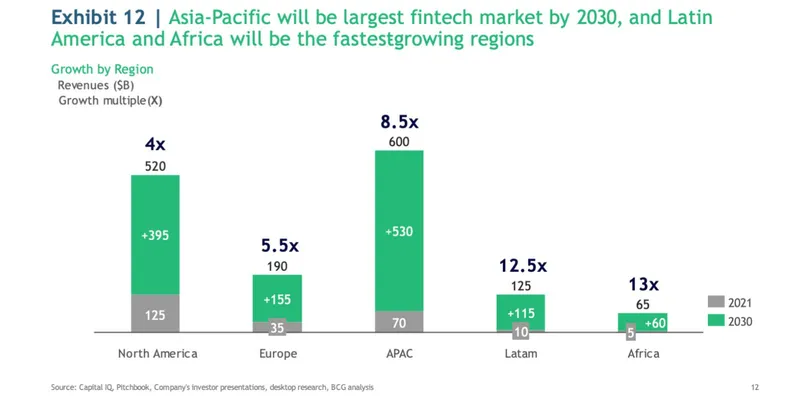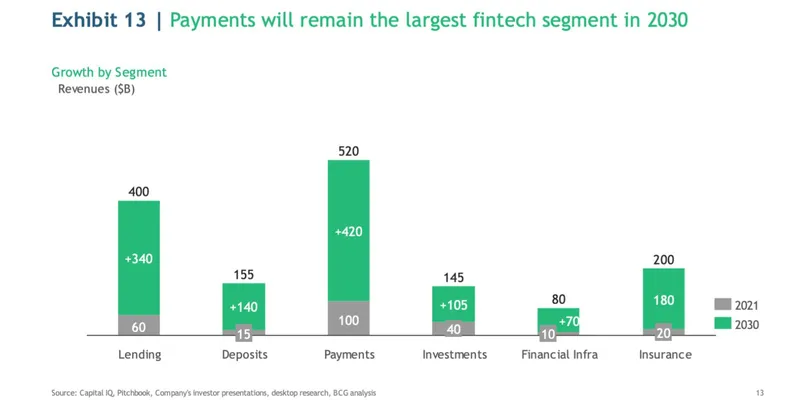Asia-Pacific (APAC) is likely to outpace the United States and become the world’s top fintech market by 2030, with a projected compound annual growth rate (CAGR) of 27%, according to a report by Boston Consulting Group (BCG) and QED Investors.
The report titled, Global Fintech 2023: Reimagining the Future of Finance, said that the majority of growth is expected to come from emerging APACs regions, including China, India, and Indonesia, compared to developed ones like Japan and South Korea, as they have the largest fintechs, voluminous underbanked populations, a high number of SMEs, and a rising tech-savvy youth and middle class.
Spotlighting India’s fintech sector, the report said the country has the opportunity to leapfrog the intermediate stages of fintech development more-developed financial markets have undergone, especially if it can benefit from supportive regulation.
“The Indian regulator is taking an active role in shaping the market through vehicles such as UPI, Aadhar, Rupay, and Digilocker,” the report added.
More than 1.3 billion Indians are enrolled in Aadhar—the largest biometric identity system in the world—while UPI processed $1.25 trillion in transactions in FY21–2022, continuing to grow fast.
It suggested that the sector’s growth will require regulators across the globe to act with urgency and thoughtfulness more holistically.
“Currently, regulators are often just “reacting” to the latest predicament. The recent series of bank crises (e.g., SVB and Crédit Suisse), along with massive financial frauds (e.g., Wirecard and FTX), have made regulators more sensitive to asset/liability management. However, while creating guardrails, they must also take care not to overregulate the industry and stifle innovation,” it said.
Expanding GDP (a CAGR of 7% per year), the rise of the educated middle class, younger demographics coming of age, and increasing fintech penetration will spur fintech revenues in India, the report added.
“Spread businesses like neobanks and lending platforms will face challenges in the developed world while playing a critical role in emerging markets,” it said, adding that further growth areas are lending, neobanking, and wealthtech segments.

Global projections, B2B2X and B2b the next hotspots
The report said it expects global financial technology revenues to grow 6X from $245 billion to $1.5 trillion by 2030.
The fintech sector, which holds a 2% share of the $12.5 trillion in global financial services revenue, is estimated to grow up to 7%, of which banking fintechs will constitute almost 25% of all banking valuations worldwide by 2030.
After payments, B2B2X and B2b (serving small businesses) will lead the next part of the fintech journey, as per the report.
B2B2X is made up of B2B2C (enabling other players to serve consumers), B2B2B (enabling other players to serve businesses), and financial infrastructure players. The growth will be supported by embedded finance and financial infrastructure, while the B2b fintech market will be led by providing solutions to credit-starved and poorly served small businesses.
Additionally, the impact of new emerging technologies like generative AI, API-based open connectivity, DLT,
quantum and edge computing, and embedded-hardware Internet of Things (IoT) and biometrics, entering the fintech arena is yet to play out.

Word of caution for fintechs
The report advised fintechs to strengthen their competitiveness and pursue aggressive strategies, including talent acquisition, gaining market share by entering new geographies/markets, and exploring M&A opportunities, while also taking an active role in shaping and embracing forward-looking regulations that enhance customer confidence and drive higher valuations.
“Venture capital firms also need to help their portfolio companies tighten their belts and become more professionalised and pursue long-term competitive moats over short-term vitality. It is important for them to help and encourage their portfolio companies to be proactive and play offence,” it said.









![Read more about the article [Funding alert] pinBox raises $1M in seed round from Venture Catalysts](https://blog.digitalsevaa.com/wp-content/uploads/2021/07/c3706fc8aa882dc65eefe8c6d6d80bf6dc392b8e6cfe32bbe565d4904f58fd4e-1625550884415-300x150.jpg)
